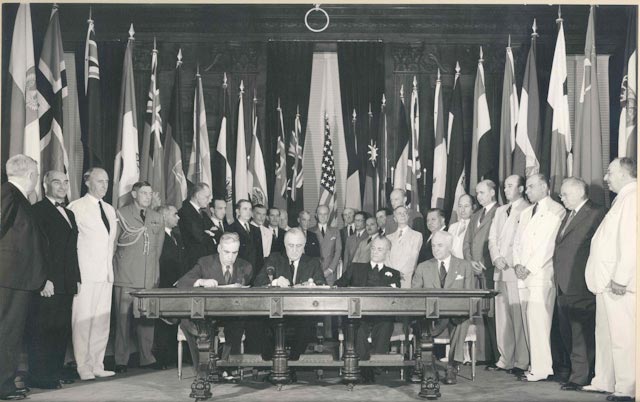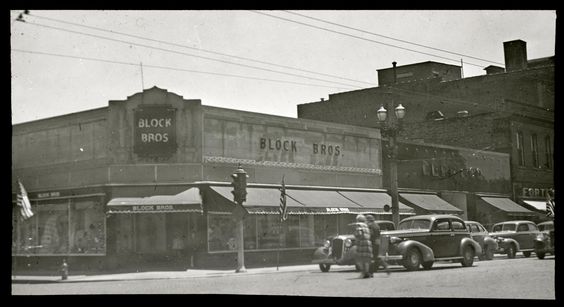Sunday 14 June 1942
 |
| Adolf Hitler and Eva Braun relaxing with their dogs at the Berghof, Berchtesgaden, 114 June 1942. Hitler is taking a break from the war before the beginning of "Case Blue," the summer offensive in the Soviet Union that he thinks will end the war. (Federal Archive B 145 Bild-F051673-0059). |
Eastern Front: General Erich von Manstein's 11th Army troops have scored a deep penetration into Soviet lines on the northern front of the Sevastopol perimeter on
14 June 1942. Manstein's forces have captured Fort Stalin, opening a wedge into the Soviet lines. The German 24th, 50th, and Romanian 4th Mountain Division advance through the central valley. The first objective is the Maxim Gorky fortress, defended by the greatly weakened Soviet 95th Rifle Division and 7th Naval Brigade.
The German also make some progress in the south, where the German 72nd and 170th Infantry Divisions advance along north the coast. The Romanian 18th Mountain Division attacks the Soviet 386th Rifle Division to keep pressure off their flank. The Luftwaffe is flying from fields just behind the front, averaging 780 sorties a day, many against Sevastopol itself.
At Fuhrer headquarters in East Prussia, General Franz Halder receives an updated casualty list for Operation Barbarossa through 10 June 1942. It shows total Heer (army) losses of 1,268,434 soldiers (39.58% of the army's establishment strength of 3.2 million). There have been 9,915 offices and 256,302 of other ranks killed, 27,282 officers and 915,575 of other ranks wounded, and 38,084 officers and 230,350 of other ranks missing. While things appear to be going well on the battlefield, the Wehrmacht in the USSR is shrinking fast.
Halder also has a conference with supply chief General Wagner. He writes: "On the whole quite satisfactory. Situation difficult in fuel and tank and AT [antitank] ammunition." Ammunition shortages plagued the Wehrmacht throughout Operation Barbarossa.
 |
| USS Wakefield arrives at King's Wharf in Wellington, New Zealand, carrying U.S. troops of the 1st Marine Division, on 14 June 1942. |
Battle of the Pacific: Following its devastating losses at the Battle of Midway, the remaining Japanese fleet arrives at Hashirajima. This completes the events directly related to the battle and this date is sometimes given as the end of the Battle of Midway.
Wounded sailors are immediately taken to naval hospitals, placed in isolation, and classified as "secret patients" so word of the disaster will not get out. The men on the ships are quickly transferred to other postings, many in remote locations in the South Pacific, without being able to see their families or give accounts of the battle. The flag officers retain their positions and are not disciplined, with Admiral Nabumo given command of the new carrier force, as his old one was completely sunk, and he begins implementing new policies such as refueling aircraft on the flight deck and not taking the extra time to bring them down to the hangar.
On the American side, of course, it is quite different. They cannot talk enough about the battle. Admiral Chester Nimitz begins drawing up an offensive campaign in the southern Solomon Islands to protect supply lines to Australia.
The Japanese public is kept completely in the dark about the epic loss. Emperor Hirohito is one of the few people outside of the military who receives accurate information.
In the Aleutians, the USAAF 11th Air Force sends four B-17s and three B-24 Liberators to attack Japanese shipping in Kiska Harbor. To B-17s are heavily damaged, and a scout seaplane is shot down - the attackers claim hits on Japanese cruisers that are not verified. A long USN PBY Catalina attacks shipping southwest of Kiska, but only scores a near-miss on light cruiser HIJMS Tama. Japanese bombers bomb Nazan Bay on Atka Island, and the Japanese send the light cruiser Abukuma accompanied by four destroyers to investigate Amchitka Island.
Battle of the Indian Ocean: German raider Thor shells and sinks 6307-ton Dutch tanker Olivia midway between Madagascar and Perth, Australia (far south of India). There are 41 deaths, with one crewman taken captive and four crewmen making landfall in Madagascar.
 |
| The Society Section of the 14 June 1942 LA Times is full of bathing beauties. |
European Air Operations: It is a quiet day on the Channel Front with no major operations.
Battle of the Atlantic: U-172 (Kptlt. Carl Emmermann), on its second patrol out of Lorient, torpedoes and sinks 8289-ton U.S. bulk carrier Lebore 200 nautical miles (370 km) north of Cristóbal, Panama. There are one death and 93 survivors, rescued by USS Erie and Tattnall.
U-504 (KrvKpt. Hans-Georg Friedrich Poske), on its third patrol out of Lorient, torpedoes and sinks 3280-ton Latvian freighter Regent 200 nautical miles (370 km) southwest of the Cayman Islands. There are 11 deaths and 14 survivors.
Norwegian 1942-ton freighter Gunvor hits a mine and sinks 25 nautical miles (46 km) north of Key West Lighthouse, Florida. There are two deaths and 20 survivors.
While forming up for Convoy HX 194 at Halifax, Nova Scotia, Swedish 3386-ton freighter Kaaparen collides with Norwegian freighter Tungsha and sinks. All 36 crew survive.
 |
| The Arizona Daily Star of Tucson, Arizona, 14 June 1942. The Battle of Midway is still being celebrated. |
Battle of the Mediterranean: German General Erwin Rommel continues his breakout from "the Cauldron," sending his panzers north to the Libyan coast. The British command reacts quickly, with Auchinleck authorizing General Ritchie, 8th Army commander, to withdraw his forces from the Gazala line west of the German advance. The retreat is not easy, as the remnants of the 50th (Northumbrian) Division must break through Italian forces (27th "Brescia" and 17th "Pavia" Divisions) to the south to make their escape. Auchinleck, under pressure from London, orders Ritchie to hold a new line. The defensive position is to run to the west of Tobruk, running southeast from Acroma through El Adem to Bir El Gubi.
It is a day of heavy and continuous Axis air and naval attacks against British convoys that are quite successful. Italian Savoia-Marchetti SM.79 bombers attack Operation Harpoon, heading east from Gibraltar (part of Operation Julius, a Malta resupply effort from both ends of the Mediterranean simultaneously). They torpedo the Royal Navy cruiser HMS Liverpool, which is part of Force W escorting convoy WS.19. The torpedo hits the starboard side at the engine room, reducing her speed to 4 knots. The Italian attacks then focus on Liverpool, and while it survives, it is further damaged by near-misses. There are 15 dead and 22 wounded
Liverpool must be towed to Gibraltar, then on to Rosyth, Scotland, for repairs and is out of service until October 945. This is despite the actual battle damage being repaired by July 1943 - there just are not enough crew available to staff her. Liverpool has had several instances of heavy battle damage, including a torpedoing on 14 October 1940 that also was done by an SM.79 and numerous bombings.
Also sunk during the SM.79 attacks is the 8169-ton Dutch freighter Tanimbar, which is part of the Gibraltar convoy, sunk south of Sardinia. In a separate action, A German motor torpedo boat (S-55) torpedoes the Royal Navy destroyer HMS Hasty off Sirte and damages her so badly that the ship must be scuttled on 15 June. Also destroyed by Luftwaffe air attacks is 6811-ton Dutch freighter Aagtekirk, which is hit after it develops engine trouble, runs aground, and burns out, with several freighters badly damaged. British 6104-ton freighter Bhutan also is sunk by the Luftwaffe. Near Malta, air attacks sink HM MTB 259 as it is being towed to Alexandria. The Italians only lose about five bombers.
The Axis attacks could have been worse, but the Luftwaffe in North Africa is grounded for most of the day by dust storms. In an illustration of the wide scope of operations, British land forces are hampered when the RAF must divert its Hawker Hurricanes and Kittyhawks to protect the convoys.
After dark, Admiral Harwood, after receiving an update from Admiral Vian sailing with the convoy, orders Operation Vigorous to be abandoned. The ships head back toward Alexandria but are harassed along the way by both Italian aircraft and the Italian surface fleet, with the battleship Littorio receiving a minor torpedo hit. Operation Harpoon, the convoy heading east from Gibraltar, continues on toward Malta, but the covering force retires to Gibraltar today, leaving the freighters on their own.
 |
| President Roosevelt, Manuel Quezon, and the Mexican Ambassador sign the United Nations Declaration. FDR Library Photograph Collection. NPx 48-22:3868(473). |
Spy Stuff: German spy George John Dasch calls the New York Office of the FBI and gives details of his sabotage mission - how he and several others landed on a Long Island beach a couple of days ago and are saboteurs. He identifies himself as "Pastorius" (After the codename for his mission) and states that he will travel down to FBI headquarters in Washington, D.C., to turn himself in.
Allied Diplomacy: Mexico and the Philippines government in exile sign the "Declaration by United Nations," begun during the Arcadia Conference in January 1942. This binds them to employ all resources against the Axis powers and forbids a separate peace. President Quezon is particularly pleased because he interprets this as the U.S. recognizing the Philippines as a separate nation and no longer a U.S. colony.
U.S. Miltary: General Electric Corporation in Bridgeport, Connecticut, finalizes the development of the M1 bazooka anti-tank rocket launcher. This is the equivalent of the Wehrmacht Panzerschreck (but not the more famous Panzerfaust), which is apparently based on a captured bazooka in North Africa in November 1942.
The U.S. 1st Marine Division begins arriving at Wellington, New Zealand.
 |
| An M1A1 Bazooka replica at the Evergreen Aviation & Space Museum in McMinnville, Oregon. |
Holocaust: In Amsterdam, Anne Frank makes her first entry in the diary she received for her 13th birthday on 12 June.
Italian Homefront: Roma beats Modena 2-0 to become Scudetto champions of Italy (Serie A). Roma will not repeat the feat until 1983.
Japanese Homeland: There is a magnitude 7.0 earthquake at a depth of 15.0 km 231 km (144 miles) east southeast of Saipan. There are no reports of anyone noticing it.
American Homefront: Today is Flag Day, and President Roosevelt gives a national radio address to commemorate the occasion. He says that "The four freedoms of common humanity are as much elements of man's needs as air and sunlight, bread and salt. Deprive him of all these freedoms and he dies—deprive him of a part of them and a part of him withers."
 |
| Block Brothers Store in Kenosha, Wisconsin, southeast corner of Sixth Avenue and 58th Street, Sunday morning, 14 June 1942 (UW-Madison Libraries). |
2022
No comments:
Post a Comment